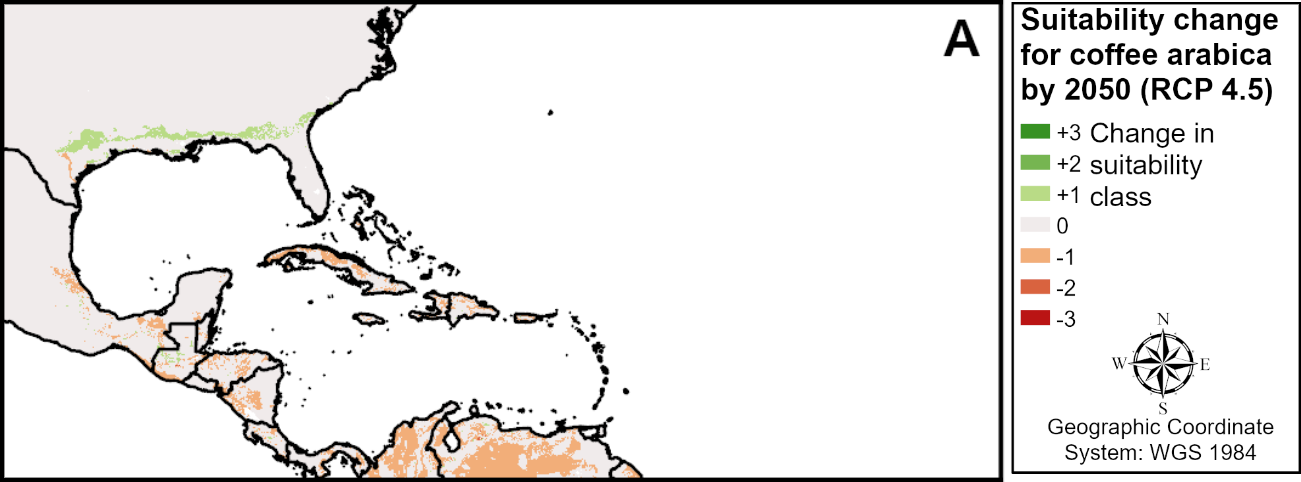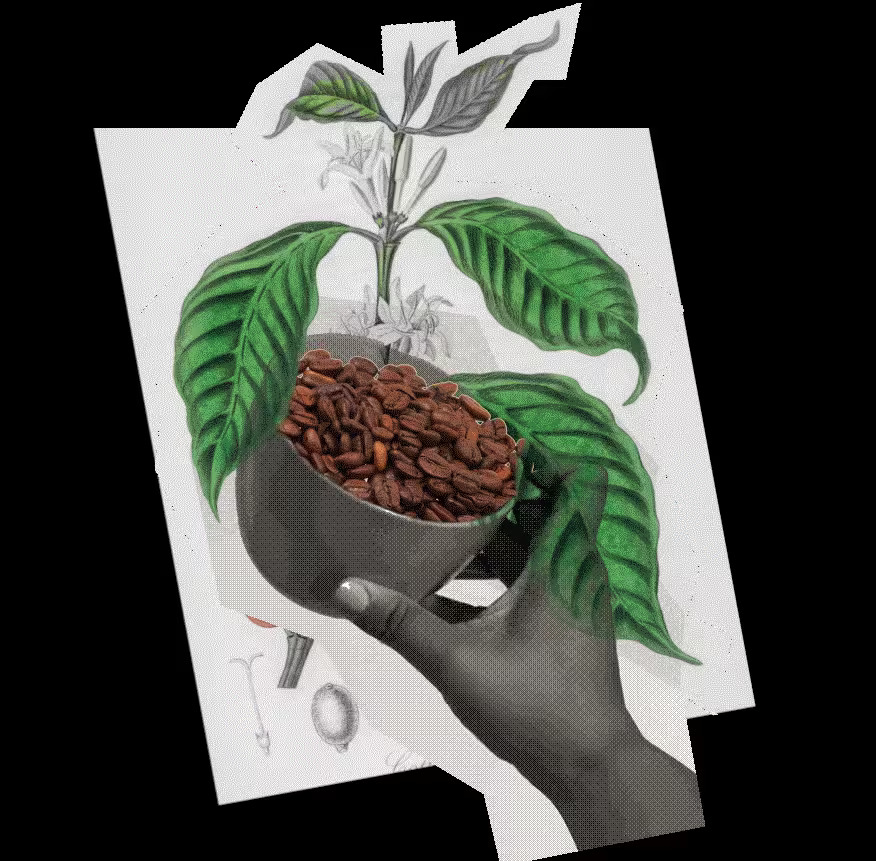Why aren’t there coffee farms in the US today?
A research article by Maya Britstein and Shannon Colin
September 25, 2024
Imagine you walk out onto your porch with your coffee mug in hand, slowly savoring your morning brew. You step into the meadow in your front yard, gazing out upon your land of fruit trees, a vegetable garden, land for your animals. Your feet take you just beyond the meadow into your forest, where you have coffee plants growing underneath timber trees. Birds are singing, squirrels are hiding their nuts. You breathe in the delicious smells of nature, appreciating that you have a farm in the mainland US growing multiple crops, coffee and otherwise, without pesticides, stewarding the land and serving as a carbon sink.
But is this realistic?... 57% of Americans say they drink coffee regularly. The majority is grown in the Global South. While some coffee is grown in Hawaii and Puerto Rico, our team has sought to determine if we could realistically grow coffee within the mainland US. Corn, soybeans, rice, sorghum, cotton, and other crops are grown in the mainland US, so why not coffee? To answer this question, we will explore the tip of the iceberg when it comes to climate requirements (like temperature and altitude) and economic requirements (like farm profitability and labor costs) that influence coffee production in the US. We find that it would probably be challenging to grow coffee within the mainland US at the scale required to meet American demand. Still, it is fun to explore the opportunities for small-scale experimentation!
Climate requirements
Coffee is primarily grown within 30 degrees of the equator due to its specific climate requirements. Coffee trees are sensitive plants; they cannot survive frost and do not thrive in extreme heat. High elevations in tropical regions provide the ideal conditions for coffee growth, with most quality coffees being cultivated at altitudes above 800 meters.
Coffee trees naturally grow under the shade of taller trees, receiving indirect sunlight. They require about 80 inches of rainfall annually, in relatively constant dry-wet seasons. Altitude moderates factors such as temperature and sun exposure, with cooler temperatures at higher elevations. There, coffee grows differently than in lowland areas. The cooler air and limited water supply cause the coffee cherries to develop smaller. The maturation process is slower in the highlands due to the colder temperatures, reduced oxygen levels, and better drainage on mountain slopes, which all restrict the growth of the coffee berries. As a result, these high-altitude berries are smaller, denser, and possess unique flavor profiles compared to their lowland counterparts. This unique combination of conditions at higher altitudes contributes to the distinct characteristics of high-quality coffee.
Due to the United States' lack of suitable tropical climates; high-altitude regions with consistent, moderate temperatures; and the necessary amount of rainfall, large-scale coffee cultivation is not feasible today in a way that would meet our demand. Some states, like California and Florida, have the right temperature ranges in certain cities, but the wrong altitude, making it challenging to grow coffee at scale.
However, future climate projections may favor coffee growing conditions in the southern USA, due to increase in minimum temperatures of the coldest month. Post harvesting processes such as fermentation, can lead to greater flavor diversification, and imitate high elevation flavor profiles. We eagerly await continued experimentation on this! The University of Florida has done experimental coffee growing within the state. FRINJ is a pioneering company growing coffee in Southern California. And The University of California, Davis has recently opened a Coffee Experimentation Center. Given the growing demand of coffee coupled with the fears that climate change will put the crop at risk, we expect continued experimentation and investment to yield interesting results. Our hope is that coffee can eventually be grown within the mainland US.

Economic requirements
One of the major barriers to growing coffee in the mainland US is the economics of farm profitability and labor. American consumers expect a cheap cup of coffee ($5/cup), but the supply chain, as it stands today, might not be sustainable for such a price.
A Caravela study found that most coffee-producing countries in Latin America only achieve low or negative profit margins when they are paid the market price for coffee. Many farmers live below the poverty line and spend 70% of their costs on labor. Many of the regeneratively farmed coffees come from co-op businesses with hundreds or thousands of small family farms each operating only several hectares of land. Imagine replicating those conditions in the mainland US, where the US agricultural laws incentivize large-scale monocropping and mechanical farming, with most subsidies going to cash crops like corn, and to the wealthiest farmers. Additionally, American farms are already struggling with a lack of labor for our existing farmland even in spite of immigration schemes meant to attract foreign workers to fill the gap.
Coffee farm workers in the Global South often experience a lack of security, privacy, safety, and sanitation in their housing and working conditions (Daily Coffee News, Perfect Daily Grind). Working men, women, and children live in tight quarters together; they lack proper safety equipment; and they are not protected by working contracts. Even in Hawaii, a US state, coffee farms have been charged with labor violations of minimum wage, overtime, and child labor requirements.
Even if the mainland US had the climate conditions required to grow coffee, farm profitability and labor costs would remain a barrier. We would ideally want to grow coffee on existing US farmland underneath existing shade trees, like the coffee that was interplanted with older avocado trees by Frinj in Santa Barbara. This would help us better leverage existing land for coffee cultivation without contributing to more deforestation. Adding the coffee crop would give farmers an additional economic opportunity to drive revenue from their current land. Quality coffee requires harvesting by hand since cherries ripen at different rates, so we would need to pay farm workers at least the minimum US federal wages to hand-harvest and process the coffee. Or perhaps we could leverage robotics, a field undergoing much development to address labor shortages and increased food demand. We would need to develop robots that can handle delicate crops like coffee in a cost-efficient way.
Looking into the future
A 2022 study on coffee production found that currently suitable land for arabica coffee growth will drastically shrink by 2050. Regions that currently produce the most coffee, like Central and South America, Central and West Africa, India, and Southeast Asia, are projected to become less suitable for the arabica coffee crop. Some regions positioned north or south of these current coffee-growing areas are projected to become more suitable for coffee crops due to warming temperatures. Places like the US, China, East and South Africa, and beyond could theoretically become hubs for growing coffee.
Due to these looming climate projections, Americans could be forced to stop drinking coffee altogether if it becomes unavailable. Other possibilities include drinking less quantity or higher quality coffee from regenerative coffee farms that intercrop under shade trees and serve as carbon sinks. We can facilitate the future of coffee by investing more into coffee farmers to help them shift their monocropping practices to more regenerative practices. We could also invest in coffee alternatives and shift consumer behavior to drinking more tap water, tea, or new “beanless” coffee products, but even these other drinks represent their own rabbit holes of climate impact. Or we could take note of shifting climate patterns and potentially invest in small-scale coffee cultivation in the South US mainland states like Florida, California, and Texas.
Whatever happens, our team hopes that the future of coffee includes sustainable land use and fair labor practices. Please reach out if you are experimenting with coffee cultivation in the mainland US - we would love to learn about and support your work!






